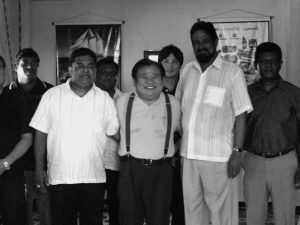
Please note that purchasing bluefin tuna is actually very difficult. Very rarely an expensive piece of bluefin tuna can turn out to have bad quality after butchering. But that does happen. I therefore have to keep an eye out for tuna at seaports and marketplaces, and at the same time also make sure of the quality and fattiness by touching the meat. I then taste a piece and try to imagine what it would be like if it was turned into a nigiri sushi before making the purchase decision. The same applies when I am sourcing from markets abroad.
Tuna caught in Japan — with the Oma in Aomori at the top — is of good quality, that is for sure. But the bluefin tuna is a migratory fish that swims from 3000 up to 5000 kilometers a year. That’s why good quality bluefin tuna can be found anywhere they migrate to. Tuna season in Japan is very limited as catching in Oma only lasts from November to January. I want to offer my customers good quality bluefin tuna any time of the year. That is why I travelled the world in my 20s in chase of the bluefin tuna’s migratory patterns.
<<In October 2012, I established a subsidiary in Sri Lanka>>
In April that hear, I had a chance to speak to the Sri Lankan fisheries minister when he visited Japan. Sri Lanka has a large workforce of fishermen, and the Indian Ocean is also an abundant source of tuna. The minister asked me to build a supply hub for tuna since that would lead to the development of local industry and boost employment. I therefore established a subsidiary for the purpose of processing and exporting tuna fish, as well as human resources development. I dispatched four offshore tuna fishing boats equipped with ultra-low temperature storage space and specialized staff to Sri Lanka, and employed locals to start the business.
Previously, the locals did not store the caught tuna refrigerated, but as it was. The local cuisine involves cutting the tuna into pieces for curry, so a bit of freshness is not as important when compared to Japanese sushi. So while explaining the differences in dietary culture, I instructed refrigeration of caught tuna inside the ship, and quick processing for export upon reaching the port factory. This made the freshness incredible, and in this manner we were able to ship several thousands of tons per year.
Tuna is prone to stress, therefore special attention is addressed to catching it. In Southern Australia haul net fishing method was used by ships using a large rectangular net to surround and catch a group of tuna in one try. This seems an optimal way as it allows for a catch of several thousand tuna at once. But since this involves cornering tuna into a net and pulling them out, the tuna crash into each other resulting in external wounds. When they get tangled into the net, they rage, causing an increase in body temperature, which results in sponginess of the flesh due to “burns” and “cracking.” Tuna caught in Japan doesn’t have these issues since pole-and-line fishing is the predominant way. Haul net fishing method usually provides only a minor percentage of quality tuna catch. Such matters are also shared at the location.
Once I flew to Morocco in response to an invitation offering good quality bluefin tuna for purchase. Fixed shore nets were used and the meat was severely damaged. The slices were preserved using salt, and this — of course — could not be used as sushi. When I explained to the local director about the Japanese way of processing, he literally cried, and told me it would take at least 3 years to implement. So instead of buying tuna, I provided education for the fishermen.
I gathered about 300 of the local fishermen in total, and divided them into: fishers, cutters, transporters and freezers. But I didn’t know who was capable of using a knife. So I first made everyone draw a long line in the beach sand with a long stick. I then designated 16 among them, who were able to draw a 2 meter long straight line as cutters. Later, after teaching everyone their roles for 2 weeks, they were able to process 150 tunas, or 30 tons in about 6 hours in a day. When we first started, it took 20 hours to process 20 tunas, so the progress made was immense. Surprised at their own improvement, even the fishermen were flabbergasted. In the end, I returned home while the teary fishermen were waving me goodbye. I knew this marked the beginning of joy and understanding through business with the peoples from all over the world.
(Interviewer: Masatoshi Ono)
Born in 1952, in the town of Sekiyado (present Noda City) in Chiba Prefecture. Graduated from Chuo University, Faculty of Law (Correspondence Course). After completion of middle school, joined the student platoon of the 4th Technical School of Japan Air Self-Defense Force. Retired from service in 1974. Joined a fishery company after working part-time jobs. Branched out on his own in 1979. In 2001, opened SUSHIZANMAI Honten (The Main Store), Japan’s first-ever sushi restaurant open 24 hours a day all year round, in the Tsukiji Outer Market.
